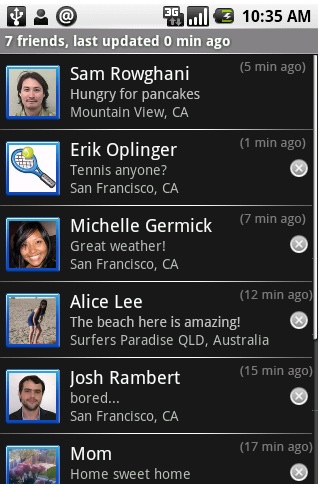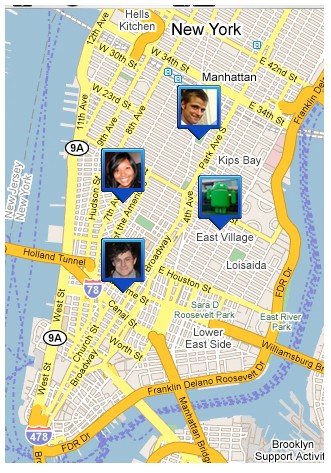
Google today announced the launch of its mobile social networking tool Latitude. This will be a component of Google Maps for Mobile and will work within native mapping applications of BlackBerrys, Symbian and Windows Mobile based devices (iPhone coming soon).
The feature will allow users to locate friends on a map and communicate with them within the context of physical location or proximity. This location will be determined using the existing My Location feature in Google Mobile Maps (for those who opt in), based on GPS and cell tower triangulation.
The tool can be accessed on mobile devices or on Google’s personalized home page, iGoogle. Users who are signed in to iGoogle can access their personal Latitude tool and get spatial updates and communications from friends. Friend networks can also be seeded with contacts that are ported over and invited through Gmail.
Generally, this comes at a good time when short messaging, or “micro-blogging” about current status or location, is gaining popularity (Twitter, Facebook status updates, etc.). Their use on mobile devices is likewise growing with Twitter mobile access (SMS and apps like Twitterific), and Facebook’s mobile explosion.
As for map-based mobile social applications like Latitude, it ties into the three-way intersection of mobile, social and local, which we’ve examined. In this respect, Latitude is similar to applications that are gaining popularity, such as Loopt and uLocate’s Buddy Beacon. Google’s entrance to the space should shed more mainstream light on it.
Local search is a key part of this, as a use case is evolving around finding things to do, see or buy locally within the context of where your friends are and what they’re doing. Social features like this will be a central tie-in to lots of mobile local search products that continue to develop. Monetization will be the lingering question mark as these products develop — as is often the case with social media.
The location relevance of mobile could make ad support easier than it’s been with online social networking. Then again, mobile comes with its own set of challenges in the form factor (small screen, limited inputs, etc.). This double-edged sword is at the heart of many of the content delivery opportunities/challenges in mobile.
More commentary to come as we put the new features to the test. In the meantime, check out Google’s video on Latitude.



This Post Has 0 Comments